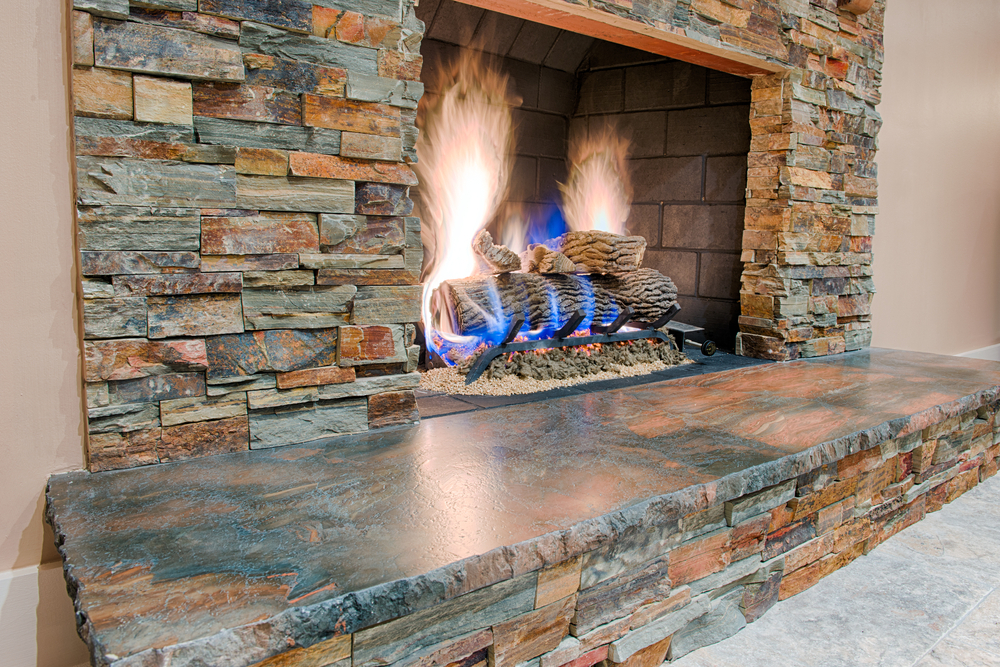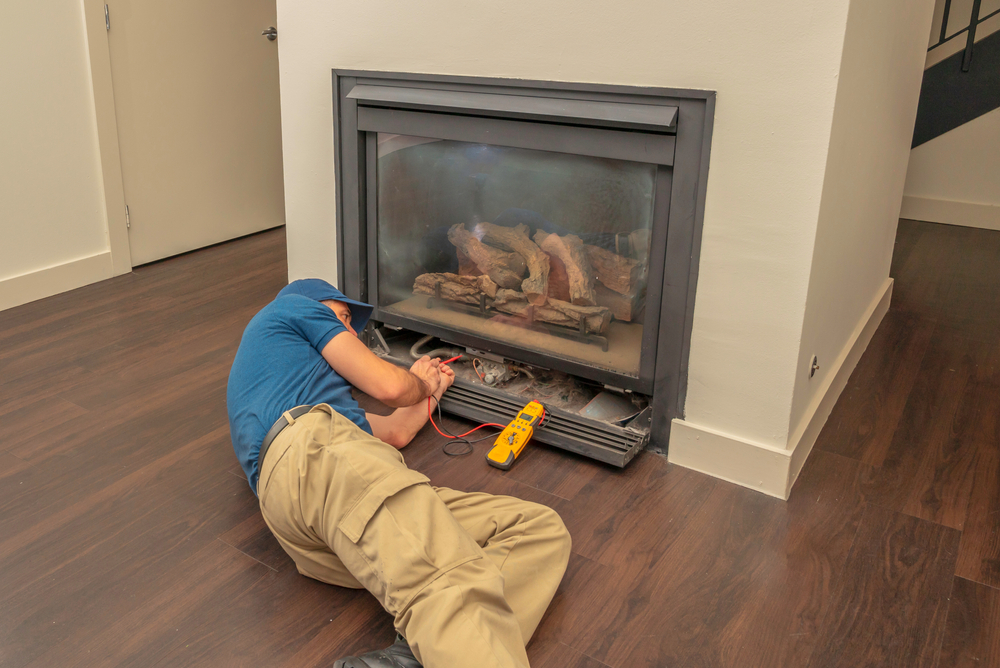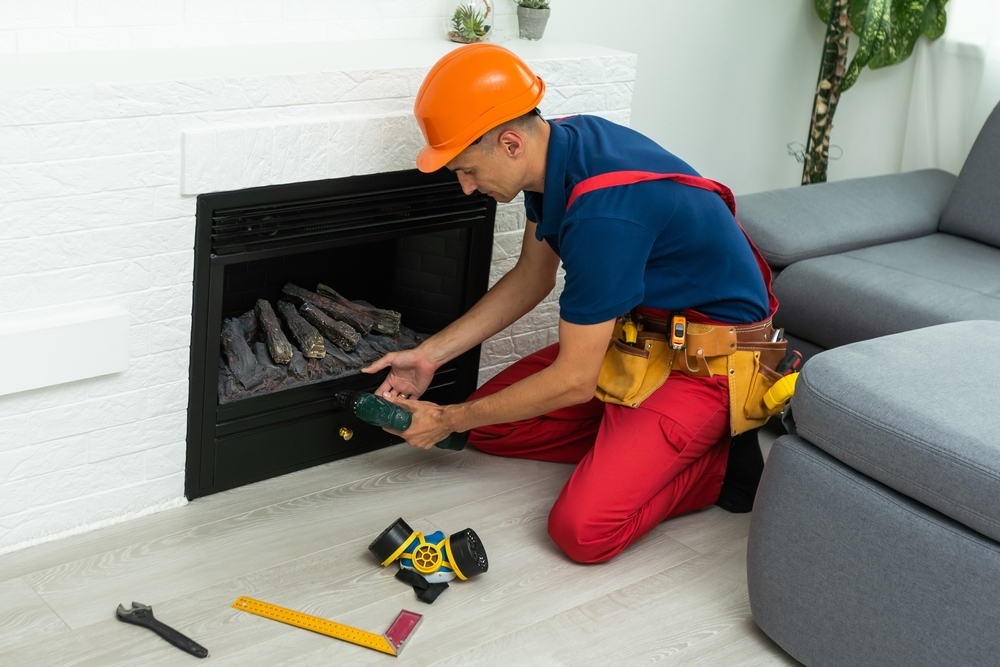Gas Fireplace Cleaning San Antonio
It can get cool in the winter or evening in San Antonio, Texas.
Did you know that your gas fireplace needs to be serviced every year to ensure safe operation?
If you are like most people you were unaware of this necessity.
It is recommended that a licensed service technician inspects your gas fireplace annually to ensure the safe, efficient, and reliable operation of your gas unit.
For the safety of your home, it is recommended that both gas fireplaces and wood-burning fireplaces including stove inserts and pellet stoves be serviced once a year. Any time you have a live-fire burning in your home you want to make sure everything is performing at optimal efficiency for safety and reliability.
Another thing to consider is that there is a higher risk of having a carbon monoxide issue due to parts wearing out if you do not get your fireplace inspected by a professional every year.
There are a lot of moving parts in gas fireplaces. Servicing those parts to make sure they have been adjusted appropriately and identifying when they need to be replaced will give you peace of mind when using your appliance. Those parts last longer when they are serviced on an annual basis saving you money in the long run.
If you don’t use your gas unit often there is a possibility of bugs and spiders in the venting living and spinning webs. This can cause issues with proper venting and can also be a factor in causing a carbon monoxide issue.
So even though gas fireplaces don’t cause creosote build up like in a wood-burning fireplace there can still be issues with parts needing to be replaced or adjusted. A yearly inspection is the best solution to keeping your family safe from carbon monoxide leaks due to unexpected failure of worn-out parts.
We offer gas fireplace repair and cleaning. Chimcare started years ago as a family-based business. Since then we have grown from one chimney sweep to a crew of licensed technicians offering you home solutions from fireplace inspection, cleaning, installation, and other related services.
Simply call to schedule an inspection in San Antonio for gas fireplace cleaning which will include the safety inspection. This service will give you peace of mind, save you money, and could save your life.
Facts about San Antonio
| Jan | Feb | Mar | Apr | May | Jun | |
|---|---|---|---|---|---|---|
| Average high in ºF | 62 | 67 | 74 | 80 | 86 | 91 |
| Average low in ºF | 39 | 42 | 50 | 57 | 65 | 72 |
| Av. precipitation in inch | 1.65 | 1.73 | 1.89 | 2.60 | 4.72 | 4.29 |
| Jul | Aug | Sep | Oct | Nov | Dec | |
|---|---|---|---|---|---|---|
| Average high in ºF | 95 | 95 | 90 | 82 | 71 | 64 |
| Average low in ºF | 74 | 74 | 69 | 59 | 49 | 41 |
| Av. precipitation in inch | 2.05 | 2.56 | 2.99 | 3.86 | 2.60 | 1.97 |
Source: https://www.usclimatedata.com/climate/san-antonio/texas/united-states/ustx1200
| hideRacial composition | 2010[69] | 1990[38] | 1970[38] | 1950[38] |
|---|---|---|---|---|
| White | 72.6% | 72.2% | 91.4% | 92.8% |
| —Non-Hispanic whites | 26.6% | 36.2% | 47.7% | n/a |
| Black or African American | 6.9% | 7.0% | 7.6% | 7.0% |
| Asian | 2.4% | 1.1% | 0.3% | 0.2% |
| Hispanic or Latino (of any race) | 63.2% | 55.6% | 44.9% | n/a |
Map of racial distribution in San Antonio, 2010 U.S. Census. Each dot is 25 people: White, Black, Asian Hispanic of any race, or other (yellow)
The U.S. Census Bureau‘s American Community Survey determined San Antonio had a population of 1,547,253 residents in 2019.[9] It had a racial and ethnic makeup of 23.9% non-Hispanic whites, 6.6% Blacks and African Americans, 0.2% American Indians and Alaska Natives, 2.8% Asians, 0.1% Native Hawaiian and other Pacific Islanders, 0.2% some other race, 1.7% two or more races, and 64.5% Hispanic or Latin American of any race.[70]
According to the 2010 U.S. census, 1,327,407 people resided in San Antonio city proper, an increase of 16.0% since 2000. The racial composition of the city based on the 2010 U.S. census is as follows: 72.6% White (non-Hispanic whites: 26.6%), 6.9% Black or African American, 0.9% Native American, 2.4% Asian, 0.1% Native Hawaiian or Pacific Islander, 3.4% two or more races, and 13.7% other races. In addition, 63.2% of the city’s population was of Hispanic or Latino origin, of any race.[69] According to the 2000 U.S. census, the city proper had a population of 1,144,646,[71] ranking it the ninth-most populated city in the country. However, due to San Antonio’s low density and relatively small suburban population, the metropolitan area ranked just 30th in the United States, with a population of 1,592,383 in 2000.[72] San Antonio has a large Hispanic population with a significant African American population.[72]
The 2011 U.S. census estimate for the eight-county San Antonio–New Braunfels metropolitan area placed its population at 2,194,927.[73] The 2017 estimate for Greater San Antonio was 2,473,974, making it the third-most populous metro area in Texas (after the Dallas–Fort Worth metroplex and Greater Houston) and the 24th-most populous metro area in the U.S.[17] The metropolitan area is bordered to the northeast by Austin–Round Rock–San Marcos, and the two metropolitan areas together combine to form a region of over 4.7 million people known as the Austin-San Antonio Corridor or Austintonio.[74][16]
About 405,474 households, and 280,993 families resided in San Antonio. The population density as of 2010 was 2,808.5 people per square mile (1,084.4 km2). There were 433,122 housing units at an average density of 1,062.7 per square mile (410.3 km2). The age of the city’s population was distributed as 28.5% under the age of 18, 10.8% from 18 to 24, 30.8% from 25 to 44, 19.4% from 45 to 64, and 10.4% who are 65 years of age or older. The median age was 32 years. In San Antonio, 48% of the population were males, and 52% of the population were females. For every 100 females, there were 93.5 males. For every 100 females age 18 and over, there were 89.7 males.
At the 2019 American Community Survey, there were 512,273 households and 319,673 families.[75] The average household size was 2.98 and the average family size was 3.83. Of the local population,[76] 201,960 were married-couple households and 172,741 were female households with no spouse or partner present. An estimated 85,462 households were single-person. Roughly 218,249 residents in San Antonio were foreign-born residents. For every 100 females, San Antonio had 97.1 males.[70]
At the 2010 U.S. census, San Antonio’s median income for a household was $36,214, and the median income for a family was $53,100. Males have a median income of $30,061 versus $24,444 for females. The per capita income for the city is $17,487. About 17.3% of the population and 14.0% of families are below the poverty line. Of the total population, 24.3% of those under the age of 18 and 13.5% of those 65 and older were living below the poverty line.[77] In 2019, households had a median income of $53,571 and a mean income of $72,587.[78] An estimated 16.8% of the population lived at or below the poverty line.[79] The city of San Antonio and its metropolis was rated the poorest in 2019.
Source: https://en.wikipedia.org/wiki/San_Antonio#Demographics
Gas Fireplace FAQs – San Antonio, Texas
How often should my gas fireplace be inspected and cleaned?
Experts recommend a professional inspection and cleaning at least once per year, even for gas units, to remove soot, check venting and pilot systems, inspect for blockages, and ensure safe combustion in accordance with NFPA 211.
What routine maintenance can I do myself?
You can wipe the glass, dust the logs, vacuum the firebox, and test carbon-monoxide detectors. However, tasks like burner cleaning, vent inspections, gas-leak testing, and ignition system checks should be done by certified technicians.
What does a professional gas fireplace service include?
A technician will clean burners, logs, and glass; inspect and tighten gas fittings; test ignition and flame sensors; check venting and chimney for obstructions such as soot, nests, or debris; and perform carbon-monoxide safety testing.
What happens if I skip annual servicing?
Skipping yearly maintenance can lead to clogged burners, ignition failures, weak or yellow flames, gas leaks, vent blockages, or smoky operation—all of which reduce efficiency and pose safety and CO poisoning risks.
Why are carbon-monoxide detectors essential near my fireplace?
Gas fireplaces can emit odorless, colorless carbon monoxide if the system malfunctions. CO detectors—required in Texas homes with fuel-burning appliances—provide early warnings that save lives.




 >
>
Leave a Reply